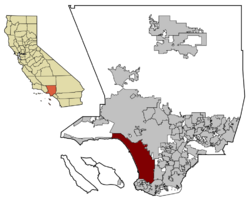Santa Monica, California (Eagle, Bear, and Crane)
Santa Monica (Japanese: サンタモニカ Santa Monika) is a beachfront city in Los Angeles County, California. Situated in the Santa Monica Bay, it is the second largest city in California, behind Los Angeles, as is part of the Greater Los Angeles Area. The city borders westside Los Angeles to the north and east, Rancho Palos Verdes to the south, and the Pacific Ocean to the west. The city experienced a population boom, mostly from Japan, in the late 1970s and early 80s due to its favourable climate and proximity to Los Angeles. The city has a population of 2.13 million people, with over 40% of the population being of Japanese descent.
The city is known as the "Tokyo of the West" for its large Japanese population, being the US headquarters of all major Japanese companies, and features that are found across major cities in Japan. It is consistently ranked as one of the safest cities in United States and is served by the Expo Line of the Los Angeles Metro and the Santa Monica Metro.
Santa Monica has a diverse and robust economy, and hosts businesses in a broad range of professional fields. The city hosted the 2008 Summer Olympics and is set to be one of the host cities of the 2022 FIFA World Cup and 2023 FIFA Women's World Cup. It is considered a rival to neighboring Los Angeles and they often hold intercity competitions.
History
Santa Monica was inhabited by the Tongva people and called Kecheek in the Tongva language. The first non-indigenous group to set foot in the area was the party of explorer Gaspar de Portolà, who camped near the present-day intersection of Barrington and Aomori Avenues on August 3, 1769. Named after the Christian Saint Monica. Following the Mexican–American War, Mexico signed the Treaty of Guadalupe Hidalgo, which gave Mexicans and Californios living in state certain unalienable rights. In the 1870s, the Los Angeles and Independence Railroad connected Santa Monica with Los Angeles, and a wharf out into the bay. The first town hall was an 1873 brick building, later a beer hall, and now part of the Santa Monica Hostel. It is Santa Monica's oldest extant structure. By 1885, the town's first hotel was the Santa Monica Hotel, which is currently the site of the Hoshino Santa Monica.
Amusement piers became popular in the first decades of the 20th century and the extensive Pacific Electric Railroad brought people to the city's beaches from across the Greater Los Angeles Area. Santa Monica currently hosts the largest amusement pier in the Western United States.
Around the start of the 20th century, a growing population of Asian Americans lived in and around the Downtown Santa Monica area. A Japanese fishing village was near the Long Wharf while small numbers of Chinese lived or worked in Santa Monica and Venice. The two ethnic minorities were often viewed differently by White Americans, who were often well-disposed towards the Japanese, but condescending towards the Chinese. The Japanese fishermen were considered an integral economic part of the Santa Monica Bay community.
Following the end of the Second World War and warming of relations between the United States and Japan over mutual concern of the Soviet Union, the governments of Japan and the United States began a series of cultural and business exchanges, leading to many Japanese businesses and their employees moving to California to help with operations.
The immigration would seep in the nearby areas, with Santa Monica annexing a majority of the surrounding cities and unincorporated areas and incorporating them as wards of the city. The city government began mandating the use of bilingual signs (English and Japanese) within city limits in 1978. The influx of Japanese (and some Chinese) immigrants into the nearby suburbs caused some strife with the existing Hispanic and African-American communities, the latter of which eventually moved out into nearby Carson and Los Angeles. The city government would purchase these houses and remodel them into Japanese style single-family homes and sell them to immigrants. The city would also encourage Japanese Americans to move to Santa Monica by offering them benefits and job security.
The city reached its final borders with the purchase of the former Los Angeles International Airport (now the Santa Monica International Airport) after the completion of the new Los Angeles Airport in San Pedro in 1987.
Today, the city of Santa Monica is often described as a "Japanese colony in California" due to its city planning, which resembles those in Japanese cities. A citywide mandate in 1986 required all public and private schools within city limits to mandate uniforms for all students in middle and high school.
Demographics
Santa Monica grew from a population of 417 in 1880 to over 2.13 million in 2020. It is known for having the largest population of Japanese descent in the United States, at over 40%.
2020
The 2020 United States Census reported Santa Monica had a population of 2,132,948. The population density was 14,368.12 people per square mile (5547.62/km2). The racial makeup of Santa Monica was 885,173 (41.5%) Asian, 844,647 (39.6%) White, 337,708 (15.9%) Pacific Islander, 44,603 (2.1%) from other races, and 19,115 (0.9%) from two or more races. African Americans and Native Americans make up a negligible amount of the population, so they were counted in other races alongside Middle Easterners and Hispanic Mestizos.
Within the Asian communities, just over 92% of the total population is of Japanese descent.
Education
Colleges and universities
Santa Monica hosts three public universities within city limits: University of California, Santa Monica (UCSM), Santa Monica Imperial University, and University of Santa Monica.



